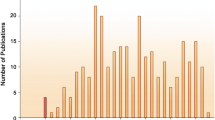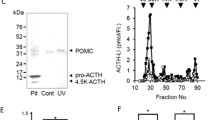Access this chapter
Tax calculation will be finalised at checkout
Purchases are for personal use only
Similar content being viewed by others
Reference
Abdel-Malek Z, Swope VB, Suzuki I et al (1995) Mitogenic and melanogenic stimulation of normal human melanocytes by melanotropic peptides. Proc Natl Acad Sci USA 92:1789–1793
Al-Omari H, al-Sugair S, Ab Hussain A (1989) Intralesional injection of tetracosactid in the treatment of localized viti-ligo. Int J Dermatol 28:682
Böhm M, Raghunath M, Sunderkotter C et al (2004) Collagen metabolism is a novel target of the neuropeptide alpha-melanocyte-stimulating hormone. J Biol Chem 279:6959–6966
Böhm M, Eickelmann M, Li Z et al (2005) Detection of functionally active melanocortin receptors and evidence for an immunoregulatory activity of alpha-melanocyte-stimulat-ing hormone in human dermal papilla cells. Endocrinology 146:4635–4646
Böhm M, Wolff I, Scholzen TE et al (2005) Alpha-melanocyte-stimulating hormone protects from ultraviolet radiation-induced apoptosis and DNA damage. J Biol Chem 280:5795–5802
Böhm M, Luger TA, Tobin DJ, Garcia-Borron JC (2006) Melanocortin receptor ligands: new horizons for skin biology and clinical dermatology. J Invest Dermatol 126:1966–1975
Brzoska T, Luger TA, Maaser C et al (2008) Alpha-melanocyte-stimulating hormone and related tripeptides: biochemistry, antiinflammatory and protective effects in vitro and in vivo, and future perspectives for the treatment of immunemediated inflammatory diseases. Endocr Rev 29:581–602
Caixia T, Daming Z, Xiran L (2001) Levels of beta-endor-phin in the plasma and skin tissue fluids of patients with viti-ligo. J Dermatol Sci 26:62–66
Cone RD, Lu D, Koppula S et al (1996) The melanocortin receptors: agonists, antagonists, and the hormonal control of pigmentation. Recent Prog Horm Res 51:287–318
Eipper BA, Mains RE (1980) Structure and biosynthesis of pro-adrenocorticotropin/endorphin and related peptides. Endocr Rev 1:1–27
Gokhale BB, Gokhale TB (1976) Corticotropin and vitiligo (preliminary observations). Br J Derrmatol 95:329
Graham A, Westerhof W, Thody AJ (1999) The expression of alpha-MSH by melanocytes is reduced in vitiligo. Ann NY Acad Sci 885:470–473
Harrison C, Smart D, Lambert DG (1998) Stimulatory effects of opioids. Br J Anaesth 81:20–28
Hernández-Pérez E (1979) Vitiligo treated with ACTH. Int J Dermatol 18:578–579
Hruby VJ, Wilkes BC, Hadley ME et al (1987) Alpha-melanotropin: the minimal active sequence in the frog skin bioassay. J Med Chem 30:2126–2130
Ichimiya M (1999) Immunohistochemical study of ACTH and alpha-MSH in vitiligo patients successfully treated with a sex steroid-thyroid hormone mixture. J Dermatol 26:502–506
Kauser S, Schallreuter KU, Thody AJ et al (2003) Regulation of human epidermal melanocyte biology by beta-endorphin. J Invest Dermatol 120:1073–1080
Kauser S, Thody AJ, Schallreuter KU et al (2004) Beta-endorphin as a regulator of human hair follicle melanocyte biology. J Invest Dermatol 123:184–195
Kieffer BL, Evans CJ (2009) Opioid receptors: From binding sites to visible molecules in vivo. Neuropharmacology, 56(Suppl 1):205–212
Kingo K, Aunin E, Karelson M et al (2007) Gene expression analysis of melanocortin system in vitiligo. J Dermatol Sci 48:113–122
Kokot A, Sindrilaru A, Schiller M et al (2009) α-Melano-cyte-stimulating hormone suppresses bleomycin-induced collagen synthesis and reduces tissue fibrosis in a mouse model of scleroderma. Arthritis Rheum 60:592–603
Lerner AB, McGuire JS (1961) The effect of alpha- and beta melanocyte stimulating hormone on the skin colour of man. Nature 189:176–79
Lerner AB, Snell RS, Chanco-Turner ML, McGuire JS (1966)Vitiligo and sympathectomy. The effect of sympath-ectomy and alpha-melanocyte stimulating hormone. Arch Dermatol 94:269–278
Miller MW, Duhl DM, Vrieling H et al (1993) Cloning of the mouse agouti gene predicts a secreted protein ubiquitously expressed in mice carrying the lethal yellow mutation. Genes Dev 7:454–467
Mozzanica N, Villa ML, Foppa S et al (1992) Plasma alpha-melanocyte-stimulating hormone, beta-endorphin, met-enkephalin, and natural killer cell activity in vitiligo. J Am Acad Dermatol 26:693–700
Na GY, Lee KH, Kim MK et al (2003) Polymorphisms in the melanocortin-1 receptor (MC1R) and agouti signaling protein (ASIP) genes in Korean vitiligo patients. Pigment Cell Res 16:383–387
Pichler R, Sfetsos K, Badics B et al (2006) Vitiligo patients present lower plasma levels of alpha-melanotropin immuno-reactivities. Neuropeptides 40:177–183
Robbins LS, Nadeau JH, Johnson KR et al (1993) Pigmentation phenotypes of variant extension locus alleles result from point mutations that alter MSH receptor function. Cell 72:827–834
Seidah NG, Benjannet S, Hamelin J et al (1999) The subtili-sin/kexin family of precursor convertases. Emphasis on PC1, PC2/7B2, POMC and the novel enzyme SKI-1. Ann N Y Acad Sci 885:57–74
Schallreuter KU, Moore J, Wood JM et al (1999) In vivo and in vitro evidence for hydrogen peroxide (H2O2) accumulation in the epidermis of patients with vitiligo and its successful removal by a UVB-activated pseudocatalase. J Investig Dermatol Symp Proc 4:91–96
Slominski A, Paus R, Wortsman J (1991) Can some melan-otropins modulate keratinocyte proliferation? J Invest Dermatol 97:747
Slominski A, Wortsman J, Luger T et al (2000) Corticotropin releasing hormone and proopiomelanocortin involvement in the cutaneous response to stress. Physiol Rev 80:979–1020
Spencer JD, Gibbons NC, Rokos H et al (2006) Oxidative stress via hydrogen peroxide affects proopiomelanocortin peptides directly in the epidermis of patients with vitiligo. J Invest Dermatol 127:411–420
Spencer JD, Gibbons NC, Böhm M, Schallreuter KU (2008) The Ca2+-binding capacity of epidermal furin is disrupted by H2O2-mediated oxidation in vitiligo. Endocrinology 149:1638–1645
Spencer JD, Schallreuter KU (2009) Regulation of pigmentation in human epidermal melanocytes by functional high affinity α-MSH/MC4-R signalling. Endocrinology 150:1250–1258
Széll M, Baltás E, Bodai L et al (2008) The Arg160Trp allele of melanocortin-1 receptor gene might protect against viti-ligo. Photochem Photobiol 84:565–571
Thody AJ, Ridley K, Penny RJ et al (1983) MSH peptides are present in mammalian skin. Peptides 4:813–816
Valverde P, Healy E, Jackson I et al (1995) Variants of the melanocyte-stimulating hormone receptor gene are associated with red hair and fair skin in humans. Nat Genet 11:328–330
Voisey J, van Daal A (2002) Agouti: from mouse to man, from skin to fat. Pigment Cell Res 15:10–18
Author information
Authors and Affiliations
Corresponding author
Editor information
Editors and Affiliations
Rights and permissions
Copyright information
© 2010 Springer-Verlag Berlin Heidelberg
About this chapter
Cite this chapter
Böhm, M. (2010). Proopiomelanocortin and Related Hormones. In: Picardo, M., Taïeb, A. (eds) Vitiligo. Springer, Berlin, Heidelberg. https://doi.org/10.1007/978-3-540-69361-1_30
Download citation
DOI: https://doi.org/10.1007/978-3-540-69361-1_30
Publisher Name: Springer, Berlin, Heidelberg
Print ISBN: 978-3-540-69360-4
Online ISBN: 978-3-540-69361-1
eBook Packages: MedicineMedicine (R0)




